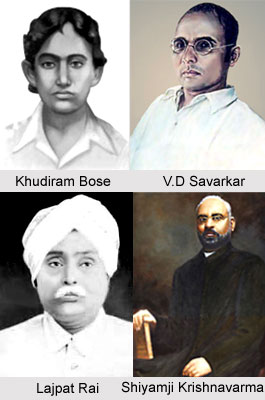 The causes that resulted into the out come of Extremism also gave rise to the revolutionary terrorist movements. The revolutionists aimed at Indian independence by radical movements. The common aim of them was `Freedom of the Motherland from British Rule`. To them, it was western method of violence that could bring an end to the Western Imperialism. They used to stage acts like murder, dacoities, looting of banks, offices and even train derailments in order to finance their projects. The first indication of revolutionary movement in India took place in Maharashtra according to the authors of the Sedition Committee Report published in the year 1918 among the Chitpavan Brahmins of the Poona District. These Brahmins were the descendants of Peshwa rules. Lord Hastings under his headship overthrew the Peshwas. The discontent towards the British led them to revolt.
The causes that resulted into the out come of Extremism also gave rise to the revolutionary terrorist movements. The revolutionists aimed at Indian independence by radical movements. The common aim of them was `Freedom of the Motherland from British Rule`. To them, it was western method of violence that could bring an end to the Western Imperialism. They used to stage acts like murder, dacoities, looting of banks, offices and even train derailments in order to finance their projects. The first indication of revolutionary movement in India took place in Maharashtra according to the authors of the Sedition Committee Report published in the year 1918 among the Chitpavan Brahmins of the Poona District. These Brahmins were the descendants of Peshwa rules. Lord Hastings under his headship overthrew the Peshwas. The discontent towards the British led them to revolt.
The Rand Murder at Poona, 1897 ---- The Chapekar Brothers (Chitpavan Brahmins) Damodar and Balkrishna on 22nd June in the year 1897 pioneered the first political murder of Europeans. They targeted Mr. Rand, the President of the Plague Committee at Poona but unfortunately Lt. Ayerst was shot. The Chapekar Brothers were caught and hanged to death.
Shiyamji Krishnavarma and India House at London ---- Shiyamji Krishnavarma a qualified lawyer chose London to work for India`s liberation from the British oppression. With this aim he also established an organization namely the India Home Rule Society or India house. The Indian sociologist was the monthly journal published from the India house. V.D Savarkar, Hardayal and Madan Lal Dhingra, a group of Indian revolutionaries became the members of India house after qualifying for the fellowship programme of Rs. 1,000. They left for London. With the membership of these young partisans, the India House matured into a center for pro-India and anti-British propaganda. Col. William Curzon Wyllie, political A.D.C to the India office in the year 1909 was shot dead by Madan Lal Dhingra of India House. As a result Dhingra was caught and hanged to death; Savarkar was deported to India and sentenced to deportation for life, Shyamji left London for Paris.
The revolutionary activities in Bengal were started with bhadralok class. Anushilan Samiti established by P. Mitra was a secret revolutionary society. The partition of Bengal led to the enlarged need of Swaraj. Many journals namely, Bhavani Mandir, the Yugantar, Sandhy started prophesying anti-British ideas. The young generation of Bengal started enrolling to the worship Bhawani as the manifestation of Shakti and to develop mental, physical, moral and spiritual strength. In the year 1907, they made an unsuccessful attempt to kill Lt. Governors of Eastern Bengal and Bengal.
The Muzaffarpur Murders and the Alipore Conspiracy Case ---- On 30th April in the year 1908, an attempt was taken to murder the Judge of Muzaffarpur and ex-chief Presidency Magistrate, Mr. Kingford. Prafulla Chaki and Khudiram Bose were charged with the bomb throwing. But unfortunately, the bomb killed two innocent ladies. Prafulla Chaki and Khudiram Bose both were caught. Chaki shot himself immediately but Bose was hanged to death. After the incident the government raided Maniktala Gardens for illicit arms and arrested 34 persons including Arobindo and Barindra Ghosh. They are judged in the Alipore Conspiracy case. At the time of trail approver Narendra Gosain, the public prosecutor, a deputy Superintendent on 24th February 1910 were shot dead. According to Rowlatt Committee report 110 dacoities and over 60 cases of attempt to murder were recorded during 1906-17.
In other provinces of India under the provisions of Regulation III of 1818 Lajpat Rai and Ajit Singh were deported. In Chandi Chowk, Delhi in December 1912, a bomb was thrown on Lord Harding on his state entry.
In order to meet the revolutionary activities, the government of India launched many acts like, The Prevention of Seditious Meetings Act 91907); The Explosive Substances Act (1908); The Indian Criminal Law Amendment Act (1908); The Newspaper (Incitement to Offences) Act, 1908, The Press Act of 1910 and The Obnoxious multi-fanged Defence of India Rules, 1915. After that, Gandhiji`s rise on the national scene through non-violent movements halted the pace of violent revolutionary activities.



















